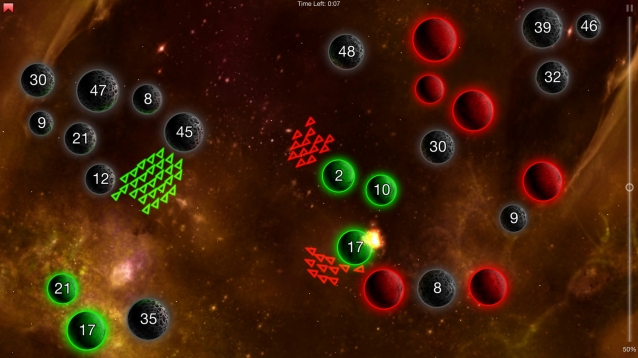Independent developer Phil Hassey’s Galcon is a fast-paced game of galactic conquest. We mean really fast-paced, with a typical round lasting a couple of minutes–complete with fleet movements and multiple planetary takeovers, retreats and reinforcements. Galcon is well-designed for short play sessions on the iPhone, and strategy game fans will have a field day swapping planets back and forth over the Internet. The game could get even better with some moderate adjustments, though.
Galcon distills the space strategy genre down to its basics: ships and planets. Planets serve as bases for your ships, as well as ship generators. The larger the planet, the faster it builds ships. Ships also have two functions: attacking and defending. To attack, you dispatch a fleet of ships, denoted by a swarm of triangles, from one (or several) of your planets towards a hostile world. If there are more ships in your fleet than there are defenders based on the planet, you gain sovereignty over the world and immediately commence building up a new fleet (you are also free to change the curtains). If you manage to take over all the planets in the galaxy, you win the game. There is no United Federation of Planets or diplomacy in Galcon; it’s all-out war, all the time.
The galactic neighborhood is a relatively small place in Galcon, and it fits nicely on your iPhone or iTouch screen. You start each game with just a single small green planet. Neutral planets–apparently inhabited by hapless, planet-bound natives–are grey in color. Grey planets can defend themselves, but cannot attack you with their own fleets. More pressing are the planets of any other color, which belong to your enemies. On the lower difficult levels of solo play, each planet has a number inside it which represents the number of defending ships. On your planets, this number tells you how many ships you have ready to protect and serve, while on grey or enemy planets, it tells you what you’re up against. This nicety gets turned off on the higher solo difficulty levels, as well as during network play.
Galcon’s controls are very adept on the iPhone. To select your ships and set out for conquest, you simply tap one or more of your planets, and then drag onto or tap on your target. 50% of your garrison on the selected planet(s) will embark by default. You can change percentage by tapping on the indicated percent in the lower right-hand corner. Adjusting how many ships you send in an attack can help tune your strategy. Do you want to pick away at the enemy, or make an all-out gamble?

The game has a handful of different modes in single-player, and a single multiplayer game type. The single-player modes change up the quantity, skill, and positioning of the computer-controlled enemies, but they are all variations on the same basic conquest theme. You can also control the AI’s skill with a sliding bar of different ranks from “Cabin Boy” to “Grand Admiral” on the home screen.
No matter which variation you choose, the arrangement of the planets will be randomly generated. This boosts replay value, but it also means that there are no high scores or saved campaigns. Considering that the distribution of planets is so critical to the game, the results of this random generation can feel very uneven, especially at higher difficulty levels. A campaign mode with scores and designed levels would have provided a better single-player challenge.
Happily, the most recent update to Galcon solved the limited novelty of the single-player game by adding local and Internet multiplayer. Up to four players can have it out at once, for some very frenetic action, with attacks from all sides. Learning the canned behaviors of the AI doesn’t prepare you for this at all, so expect your first few rounds to go quickly and unfavorably. Stats and rankings are all provided at www.galcon.com, to measure the depth of your defeat and the height of your triumph.
There are some awkward flaws in the multiplayer features, however. For instance, you have to set up your account using a full browser, preferably on a computer. Furthermore, the player stats and profiles are only available via Safari, and you cannot get the player profiles of your opponents without memorizing or writing down their names. The multiplayer experience is still great, but it’s marred a bit by these shortcomings.

Galcon’s graphics also fall a bit short. They’re simple and functional, but definitely amateurish. The production values just don’t measure up compared to other games at this price point. The game’s sounds are similarly rudimentary, with some minimalist whooshes and explosions as fleets launch and planets are attacked, respectively. On the other hand, Galcon is a good iPhone audio citizen, allowing you to provide your own soundtrack, or even talk on the phone while playing�”great for those boring conference call meetings with your editor. Also, unlike a few big-budget titles we could mention, Galcon honors the mute switch.
All in all, Galcon is a great game with a few moderate shortcomings. We’re awarding it a 3 at present time, even with its limited solo play appeal, its relatively low-rent production values, and some hiccups in its multiplayer function taken into account. It’s not that far off from achieving “Must Have” status, as long as the developer puts in a little more effort.